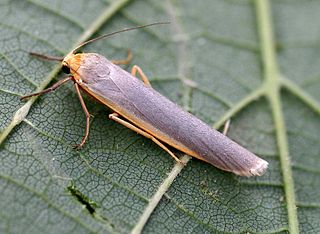
The Indian fritillary is a species of butterfly of the nymphalid or brush-footed family. It is usually found from south and southeast Asia to Australia.

Manulea complana, the scarce footman, is a moth of the family Erebidae. The species was first described by Carl Linnaeus in his 1758 10th edition of Systema Naturae. It is found throughout the Palearctic region.
Emphylica is a monotypic moth genus of the family Crambidae described by Alfred Jefferis Turner in 1913. It contains only one species, Emphylica xanthocrossa, described in the same article, which is found in Australia, where it has been recorded from the Northern Territory.

Thyas coronata is a species of moth of the family Noctuidae first described by Johan Christian Fabricius in 1775. It is found from the Indo-Australian tropics of southern China, Taiwan, Japan, Nepal, India, Sri Lanka to Micronesia and the Society Islands.
Cyclotorna diplocentra is a moth of the family Cyclotornidae. It is found in Australia, including New South Wales and Queensland.
Gastridiota is a monotypic genus consisting solely of Gastridiota adoxima, a moth of the family Bombycidae. The genus was erected by Alfred Jefferis Turner in 1922 but the species had been described by him in 1902 as Andraca adoxima. It is found in the subtropical east of Australia, from the Bunya Mountains and Montville in southern Queensland to north-eastern New South Wales.
Spilarctia nobilis is a moth in the family Erebidae. It was described by Alfred Jefferis Turner in 1940. It is found in Australia, where it has been recorded from Queensland.
Scoparia tritocirrha is a moth in the family Crambidae. It was described by Alfred Jefferis Turner in 1918. It is found in Australia, where it has been recorded from Norfolk Island.
Archernis argocephala is a moth in the family Crambidae. It was described by Oswald Bertram Lower in 1903. It is found in Australia, where it has been recorded Queensland.
Syllepte phricosticha is a moth in the family Crambidae. It was described by Turner in 1908. It is found in Australia, where it has been recorded from Queensland.
Syllepte trachelota is a moth in the family Crambidae described by Alfred Jefferis Turner in 1913. It is found in Australia, where it has been recorded from Queensland.
Voliba leptomorpha is a moth in the family Crambidae. It was described by Turner in 1908. It is found in Australia, where it has been recorded from Queensland.
Cotana neurina is a moth in the family Eupterotidae. It was described by Turner in 1922. It is found in Australia, where it has been recorded from Queensland.
Idioglossa metallochrysa is a very small species of golden-metallic coloured moth of the family Batrachedridae living in a subtropical highland climate, at least in Australia, and of which the caterpillars feed on the plant Cheilocostus speciosus, at least in Indonesia.
Atasthalistis pyrocosma is a moth in the family Gelechiidae. It was described by Edward Meyrick in 1886. It is found on New Guinea and Australia, where it has been recorded from Queensland.
Brachybelistis neomorpha is a moth in the family Xyloryctidae. It was described by Turner in 1898. It is found in Australia, where it has been recorded from New South Wales, Queensland and South Australia.
Illidgea aethalodes is a moth in the family Xyloryctidae. It was described by Alfred Jefferis Turner in 1902. It is found in Australia, where it has been recorded from the Northern Territory and Queensland.

Eupselia axiepaena is a moth in the family Depressariidae. It was described by Alfred Jefferis Turner in 1947. It is found in Australia, where it has been recorded from Queensland.
Agriophara leucanthes is a moth in the family Depressariidae. It was described by Alfred Jefferis Turner in 1898. It is found in Australia, where it has been recorded from Queensland.
Imma platyxantha is a moth in the family Immidae. It was described by Turner in 1913. It is found in Australia, where it has been recorded from Queensland.



